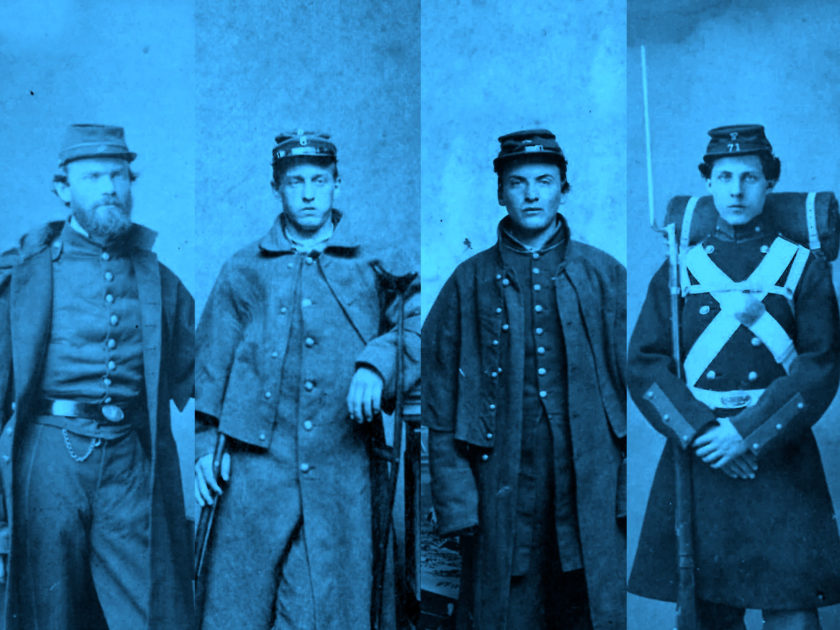By Michael J. McAfee
When Massachusetts militiamen wearing varying uniforms, even within regiments, left the state, they were provided gray overcoats specially ordered by Gov. John Andrew to give a semblance of uniformity to Massachusetts’ first volunteers.
If other first volunteers came unprepared, and their state could not provide for them, the federal government did its best to meet their needs. Months later, on Aug. 28, 1861, Sgt. Thomas Booth of the 36th Ohio Infantry recorded the receipt of uniforms in his diary: “Black overcoats, with capes; Grey flannel shirts; socks and shoes and blue pants. We also drew smooth bore muskets and accouterments.” Booth did not receive the overcoat of sky blue flannel kersey that would become standard issue later in the war.
The federal supply system experienced an overcoat problem by the summer of 1861. Quartermaster General Montgomery Meigs realized that finding enough sky blue kersey cloth to manufacture the needed overcoats for the fall and winter was not possible. There had been insufficient quantities of good cloth to provide uniforms for the mass of volunteer soldiers recruited in the late spring of that year. Meigs knew he had to be flexible. In July, he postponed the production of overcoats as unnecessary for the summer season. But by October, he could no longer defer the matter. First, he authorized the purchase of gray overcoats. Then, on October 14, he instructed quartermasters to make up overcoats of “the best material they can find.” Later in the month, he wrote, “Send here at once ten thousand overcoats. Light or Dark Blue, in fact any color will be acceptable… except grey.” When Booth drew his first overcoat it was of black cloth.
Shortages of cloth and supply issues were common early in the war.
Sky blue overcoats for federal enlisted men of horse and foot troops were regulation during the Civil War. But militiamen had the option of purchasing regimental overcoats of differing colors and federal styles and patterns. The venerable 7th New York chose to wear the sky blue overcoats. Others, such as the 9th, 14th and 71st New York regiments, adopted dark blue cloth for their overcoats. Moreover, overcoats without capes were not uncommon for militia soldiers, whose most inclement weather duties may have been for parades on Evacuation Day (November) in New York City and Washington’s Birthday (February).
Without regimental Bills of Dress or color prints, it is not possible to determine who wore gray overcoats rather than sky blue in period photography. But undoubtedly, gray was also used. While many militia units went to war with their regimental overcoats, most militia called into federal service by 1862 had the option of drawing federal uniforms.
Though they did not change the color of federal overcoats, soldiers found other ways to “improve” them. The most common alterations involved the removal of capes and the addition of outer pockets.
Still, no matter the color or shape of the overcoat, those overcoats that went out on campaign in the spring were most often discarded by the summer, and left by the roadside for scavengers.

Variations (from left to right)
THIS IMAGE OF A CORPORAL in the 9th New York State Militia (83rd New York Infantry) dates to May 11, 1861. He wears a regimental overcoat of dark blue with red cuffs. The cape was detachable.
Carte de visite by an anonymous photographer.
WITH HIS CRUTCHES by his side, a soldier in the 6th Massachusetts Volunteer Militia wears one of Gov. Andrews’ gray overcoats.
Carte de visite by Silsbee, Case & Co. of Boston, Mass.
THIS MIDWEST SOLDIER wears a non-standard dark overcoat, undoubtedly one of the fall and winter of 1861 issuances.
Carte de visite by an anonymous photographer.
THIS PRIVATE in the 71st New York State Militia wears a dark blue overcoat, most likely trimmed in sky blue to match the facings of the dress coat. He is fully accoutered, and has his box knapsack as well.
Carte de visite by Mathew B. Brady of New York City.
MI Senior Editor and Advisory Board member Michael J. McAfee is a curator at the West Point Museum at the United States Military Academy, and author of numerous books. He has curated major museum exhibitions, and has contributed images and authoritative knowledge to other volumes and projects. The cartes de visite here are from the author’s collection.
SPREAD THE WORD: We encourage you to share this story on social media and elsewhere to educate and raise awareness. If you wish to use any image on this page for another purpose, please request permission.
LEARN MORE about Military Images, America’s only magazine dedicated to showcasing, interpreting and preserving Civil War portrait photography.
VISIT OUR STORE to subscribe, renew a subscription, and more.

